Isfahan, often referred to as “Half the World” due to its stunning beauty and rich cultural heritage, is a city that boasts some of Iran's most exquisite historical landmarks. Located in central Iran, Isfahan is home to a wealth of architectural marvels that reflect its storied past and the grandeur of Persian civilization.
Top Isfahan Historical Places
Isfahan, often hailed as a jewel of Persian architecture and culture, boasts a plethora of historical landmarks that captivate visitors with their beauty and historical significance. The city is renowned for its breathtaking mosques, palaces, bridges, and gardens that captivate visitors with their intricate designs and historical significance. At the heart of the city lies the magnificent Naqsh-e Jahan Square, a UNESCO World Heritage site surrounded by some of Isfahan's most iconic buildings, including the Shah Mosque, known for its stunning blue tiles and grand dome, the Sheikh Lotfollah Mosque, renowned for its exquisite interior design, and the Ali Qapu Palace, which offers panoramic views of the square. The city is also home to the Si-o-se-pol Bridge and the Khaju Bridge, both masterpieces of Safavid-era engineering that span the Zayandeh River with their graceful arches and intricate tilework. Another must-see is the Chehel Sotoun Palace, a splendid pavilion set in a lush garden, famous for its twenty columns that reflect beautifully in the adjacent pool. The Jameh Mosque of Isfahan, with its intricate mosaics and architectural evolution over centuries, is another highlight, providing a deep connection to the city's rich Islamic heritage.
Naqsh-e Jahan Square
Naqsh-e Jahan Square, also known as Imam Square, is a breathtaking UNESCO World Heritage site located in the heart of Isfahan, Iran. This grand square, one of the largest in the world, was constructed in the early 17th century during the Safavid dynasty under the rule of Shah Abbas I. The square measures approximately 160 meters wide and 560 meters long, creating an expansive space surrounded by some of the most iconic architectural masterpieces of Persian history.
At the center of Naqsh-e Jahan Square, you are enveloped by the beauty and grandeur of its surrounding landmarks. The Shah Mosque, with its stunning blue-tiled dome and towering minarets, is a masterpiece of Islamic architecture. The intricate tile work and calligraphy that adorn its walls are a testament to the artistic genius of the Safavid era. On the eastern side of the square stands the Sheikh Lotfollah Mosque, renowned for its exquisite interior design and unique, single-domed structure. This mosque, built as a private sanctuary for the royal court, boasts a stunning play of light and color that changes throughout the day.
The Ali Qapu Palace on the western side of the square offers a different yet equally captivating experience. This grand palace served as the residence of the Safavid rulers and a gateway to the royal complex. Its towering terrace provides panoramic views of the square and beyond, while its music room features intricate stucco work designed to enhance acoustics. On the northern end of the square lies the Qeysarieh Bazaar, a vibrant marketplace that has been the heart of commerce and trade for centuries. Here, visitors can explore a labyrinth of shops selling traditional crafts, textiles, and spices, offering a glimpse into the rich cultural heritage of Isfahan.
Sheikh Lotfollah Mosque
Sheikh Lotfollah Mosque, located on the eastern side of Naqsh-e Jahan Square in Isfahan, is one of Iran's architectural masterpieces and a testament to the artistic achievements of the Safavid era. Constructed between 1602 and 1619 during the reign of Shah Abbas I, this mosque was designed by the prominent architect Mohammad Reza Isfahani. Unlike other mosques, Sheikh Lotfollah Mosque does not have minarets or a courtyard, as it was built as a private place of worship for the royal family.
The mosque is renowned for its stunning tilework and intricate design, particularly its magnificent dome, which features an intricate pattern of blue and cream-colored tiles. The unique dome creates a spectacular play of light and shadow, changing colors throughout the day and offering a different visual experience at various times. Inside, the mosque's interior is adorned with exquisite mosaics, calligraphy, and arabesque patterns that demonstrate the high level of craftsmanship during the Safavid period.
One of the most remarkable features of Sheikh Lotfollah Mosque is its entrance portal, which leads to a long, dimly lit passageway that twists and turns, creating a sense of mystery and anticipation before reaching the main prayer hall. This architectural design was intentional, meant to evoke a spiritual journey and prepare worshippers for prayer. The prayer hall itself is a marvel, with its intricately decorated walls and ceilings that are a visual feast of detailed tilework and harmonious patterns.
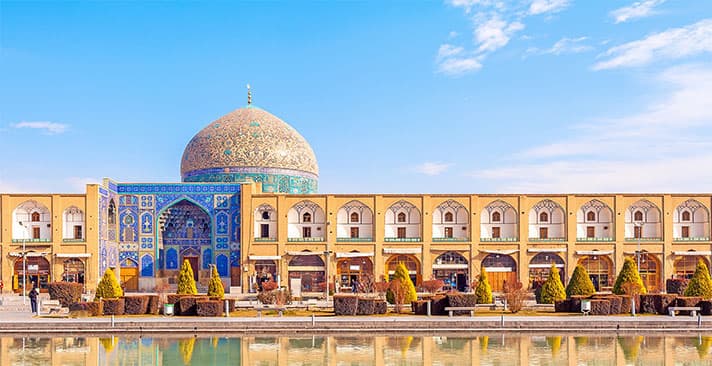
Shah Mosque
Shah Mosque, also known as Imam Mosque, is one of the most stunning examples of Islamic architecture in Isfahan and a prominent symbol of Persian craftsmanship. Constructed during the reign of Shah Abbas I in the early 17th century, this mosque is a key highlight of Naqsh-e Jahan Square, a UNESCO World Heritage site. The mosque's design and construction reflect the artistic and architectural excellence of the Safavid era, showcasing intricate tilework, grandiose domes, and minarets.
The entrance to Shah Mosque is marked by a majestic portal adorned with intricate tile patterns in vibrant hues of blue and turquoise. This gateway leads to a spacious courtyard surrounded by arcades and iwans (vaulted halls). Each iwan is meticulously decorated with exquisite mosaics and calligraphy that highlight Quranic verses and floral motifs, creating a breathtaking visual experience.
One of the mosque's most remarkable features is its grand dome, which stands at a height of 52 meters. The interior of the dome is adorned with delicate tilework that forms a complex pattern of geometric shapes and arabesques. The acoustics within the mosque are designed to amplify sound, enhancing the experience of prayers and recitations.
The prayer hall, supported by massive columns and illuminated by natural light filtering through stained glass windows, exudes a sense of serenity and spiritual grandeur. The mosque's mihrab, the niche indicating the direction of Mecca, is intricately decorated with intricate tilework and floral designs.
The two towering minarets, each rising to a height of 48 meters, frame the mosque's facade and are beautifully adorned with blue tiles and calligraphic inscriptions. The symmetry and harmony of the mosque's design elements reflect the Safavid dynasty's emphasis on beauty, balance, and spiritual devotion.
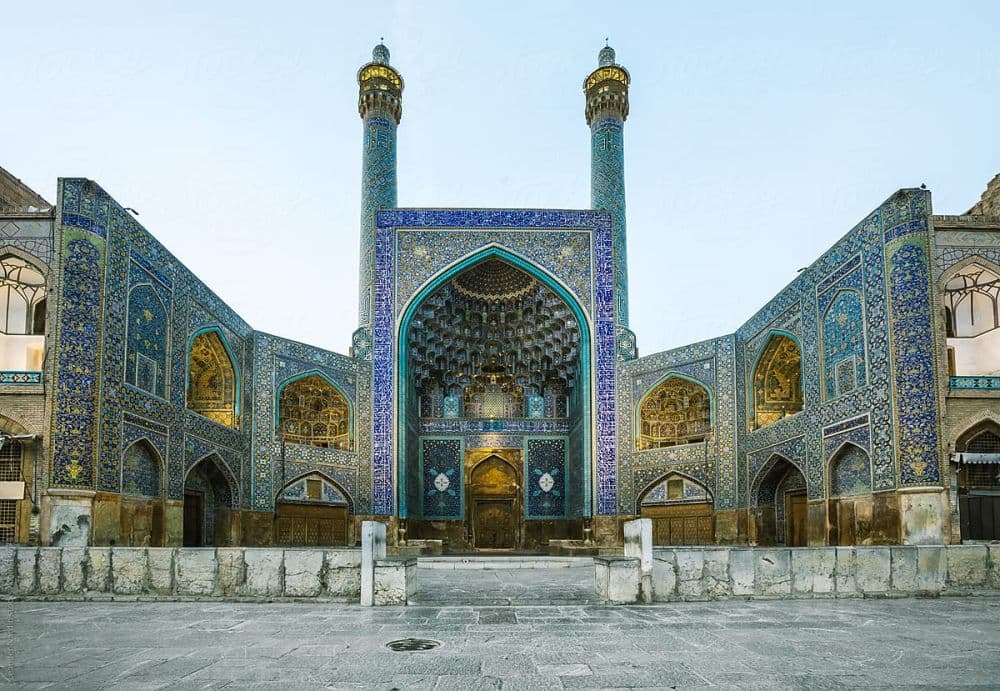
Vank Cathedral
Vank Cathedral, also known as the Holy Savior Cathedral, is one of the most remarkable and historically significant churches in Isfahan, Iran. Located in the Armenian quarter of the city, known as New Julfa, this cathedral stands as a testament to the rich cultural and religious heritage of the Armenian community in Isfahan. Vank Cathedral was built in the early 17th century, during the reign of Shah Abbas I, who relocated a large number of Armenians to Isfahan as part of his efforts to boost trade and cultural exchanges.
The exterior of Vank Cathedral features a modest and traditional Armenian architectural style, with its plain brickwork and dome. However, stepping inside reveals a stunning contrast, as the interior is richly decorated with elaborate frescoes, gilded carvings, and intricate tile work. The walls and ceilings of the cathedral are adorned with vivid and detailed paintings that depict scenes from the Bible, the story of creation, the life of Christ, and the Last Judgment. These frescoes are notable for their blend of Armenian and Persian artistic influences, creating a unique and visually captivating experience.
The main sanctuary of Vank Cathedral is an awe-inspiring space, illuminated by natural light that filters through the stained glass windows, casting a colorful glow on the ornate decorations. The altar, intricately carved and gilded, stands as the focal point of the cathedral, flanked by beautifully painted panels and icons. The cathedral also houses a small museum that displays a collection of Armenian artifacts, manuscripts, and historical documents, providing insight into the history and culture of the Armenian community in Isfahan.
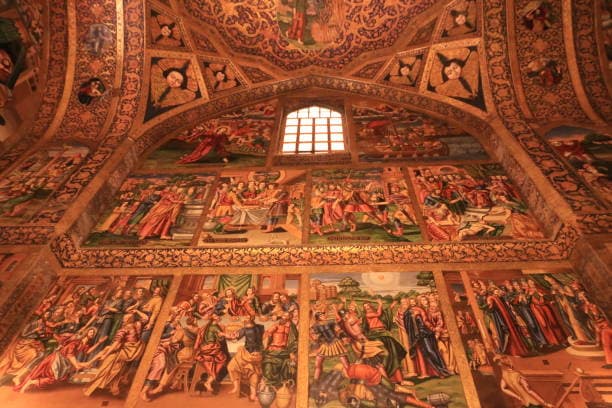
Khaju Bridge (Pol-e Khajoo)
Khaju Bridge (Pol-e Khajoo), located in Isfahan, is one of the most iconic and architecturally stunning bridges in Iran. Constructed in the mid-17th century under the rule of Shah Abbas II of the Safavid dynasty, this bridge is renowned for its artistic design and historical significance. Khaju Bridge spans the Zayandeh River and serves not only as a functional crossing but also as a public gathering space and a work of art.
The bridge's structure consists of 23 arches and spans a length of approximately 133 meters. Its unique design features a central pavilion, known as a “Shahneshin”, where the Shah and his court could sit and enjoy the view of the river. The bridge is adorned with intricate tile work and stone carvings, showcasing the artistic craftsmanship of the Safavid era. The two-story design of Khaju Bridge includes an upper walkway, which is used for pedestrian traffic, and a lower level, which was originally designed to regulate the flow of the river and provide a place for public gatherings.
Khaju Bridge is especially famous for its dual functionality as both a dam and a bridge. The lower arches contain sluice gates that can be opened or closed to control the water level and irrigation of the surrounding gardens. This ingenious design reflects the advanced engineering skills of the Safavid period.
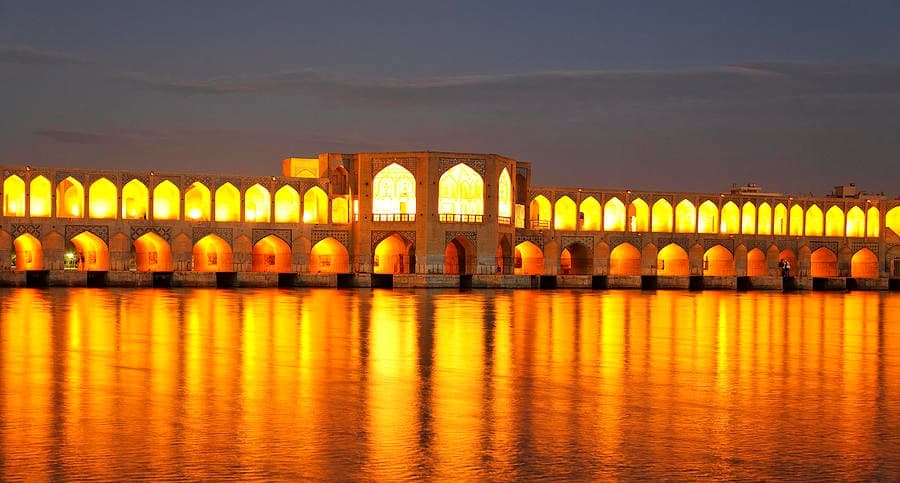
Si-O-Se Pol Bridge
Si-O-Se Pol Bridge, also known as the Bridge of Thirty-Three Arches, is one of Isfahan's most iconic and architecturally impressive structures. Built during the early 17th century under the patronage of Shah Abbas I, this bridge is a remarkable example of Safavid-era engineering and design. Spanning the Zayandeh River, Si-O-Se Pol stretches for approximately 297 meters, making it the longest bridge in Isfahan. Its name, "Si-O-Se Pol," translates to "Thirty-Three Bridge," referring to the 33 arches that form its elegant, symmetrical structure.
The bridge's two-tiered design was not only functional but also aesthetically pleasing. The upper level, used primarily by pedestrians, offers a wide walkway flanked by intricately decorated arches, providing stunning views of the river and the city. The lower level features a series of galleries that were originally designed to regulate the water flow and serve as a space for public gatherings. This dual-purpose design reflects the ingenuity and multi-functional approach of Persian architecture.
One of the most captivating aspects of Si-O-Se Pol Bridge is its ability to transform with the seasons. During the dry months, the bridge's arches stand tall above the riverbed, creating a dramatic silhouette against the skyline. In contrast, when the river is full, the reflections of the arches in the water create a mesmerizing and almost magical scene, often celebrated in Persian art and poetry.
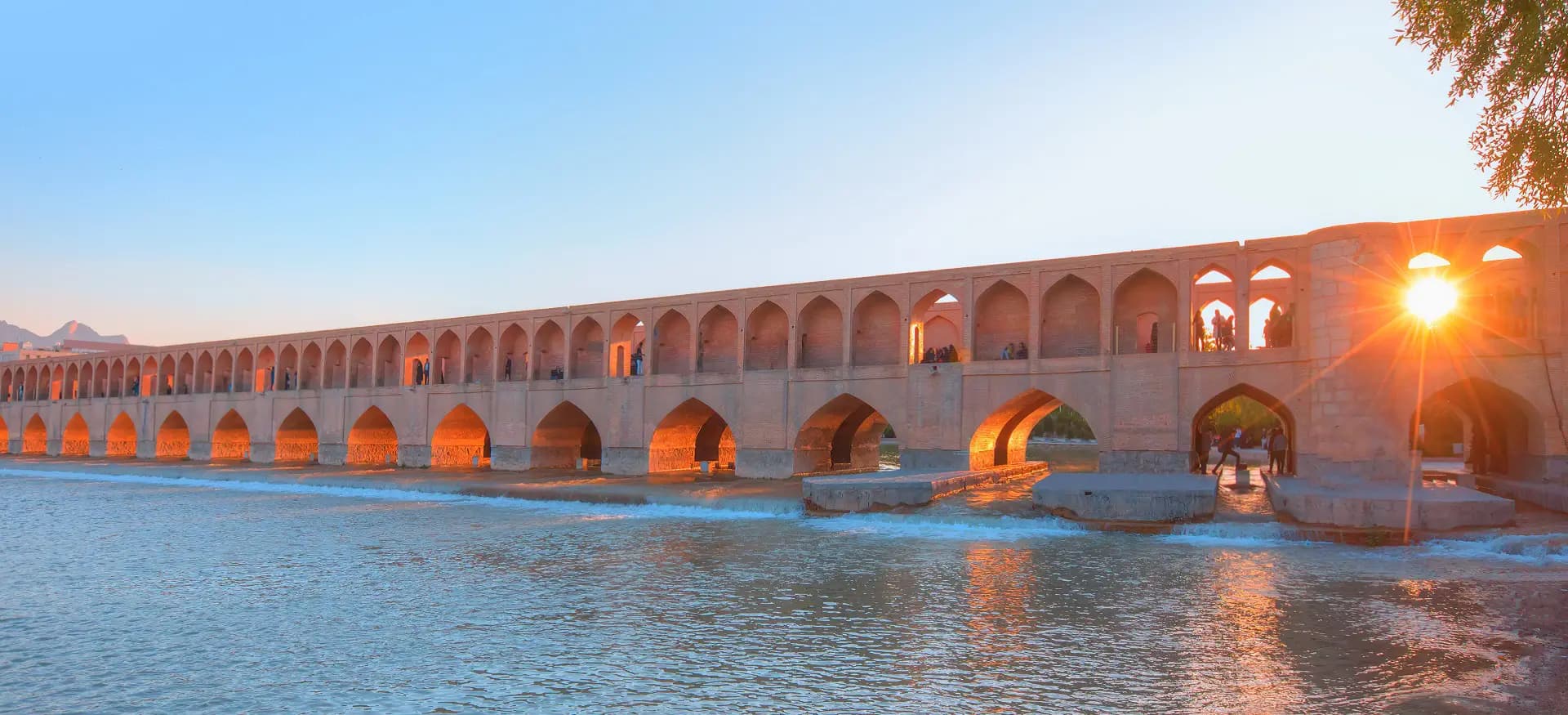
Jameh Mosque of Isfahan
The Jameh Mosque of Isfahan, also known as the Congregational Mosque, stands as a monumental testament to the evolution of Islamic architecture over centuries. Located in the historic heart of Isfahan, this mosque is one of the oldest in Iran, with its foundations dating back to the 8th century. The mosque has undergone numerous renovations and expansions throughout different dynasties, each contributing to its architectural diversity and grandeur. The Jameh Mosque covers an extensive area, showcasing a blend of architectural styles from the Seljuk, Ilkhanid, Timurid, and Safavid periods.
One of the most striking features of the Jameh Mosque is its four-iwan courtyard, a design that became a model for Persian mosques. The courtyard is surrounded by four grand iwans, each facing one another, creating a harmonious and symmetrical layout. The south iwan, known as the Maqsura, is particularly impressive with its towering height and intricate brickwork, featuring elaborate muqarnas (stalactite-like decorations) and calligraphic inscriptions.
Inside the mosque, visitors are greeted by a labyrinth of halls, chambers, and prayer rooms, each adorned with exquisite tile work, stucco carvings, and magnificent domes. The Nizam al-Mulk Dome and the Taj al-Mulk Dome are architectural marvels of the Seljuk era, celebrated for their innovative structural design and artistic beauty. The mosque's mihrab, the niche indicating the direction of Mecca, is a masterpiece of tile work and calligraphy, reflecting the high level of craftsmanship during the Ilkhanid period.
The Jameh Mosque of Isfahan is not only a place of worship but also a historical museum that encapsulates the artistic and architectural achievements of various Islamic dynasties. It has been designated a UNESCO World Heritage site, recognizing its cultural and historical significance. Visitors to the Jameh Mosque can experience a journey through time, marveling at the layers of history and the continuous evolution of Persian Islamic architecture. The mosque remains an active place of prayer and a vibrant symbol of Isfahan's rich heritage, attracting scholars, historians, and tourists from around the world.
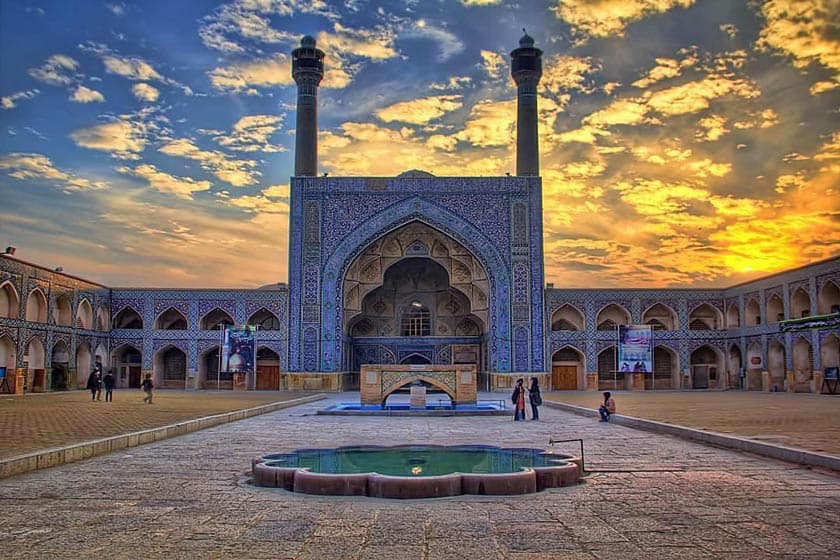
Chehel Sotoun
Chehel Sotoun, also known as the Palace of Forty Columns, is a stunning pavilion located in the heart of Isfahan, Iran. This magnificent structure was constructed in the mid-17th century during the reign of Shah Abbas II, one of the prominent rulers of the Safavid dynasty. Chehel Sotoun was designed to serve as a royal entertainment pavilion and a reception hall for dignitaries and foreign ambassadors, showcasing the opulence and grandeur of the Safavid era.
The name "Chehel Sotoun" translates to "Forty Columns," derived from the twenty slender wooden columns that support the grand entrance porch. These columns are reflected in the adjacent pool, creating the illusion of forty columns and giving the palace its name. The pavilion's architectural design combines Persian and Islamic elements, featuring intricate tile work, stucco decorations, and elegant frescoes that depict historical scenes and royal ceremonies.
The interior of Chehel Sotoun is equally impressive, with its richly adorned halls and chambers. The central hall, known as the Throne Hall, is particularly notable for its lavish decorations, including intricate mirror work, gilded surfaces, and vivid frescoes that illustrate the grandeur of the Safavid court. These frescoes provide valuable insights into the cultural and political life of the period, depicting scenes of battles, banquets, and diplomatic receptions.
Surrounding Chehel Sotoun is a beautifully landscaped Persian garden, complete with water features, fountains, and lush greenery. The garden's design reflects the traditional Persian concept of paradise, offering a serene and tranquil environment that complements the elegance of the pavilion. Visitors can stroll through the garden, enjoying the harmonious blend of nature and architecture.
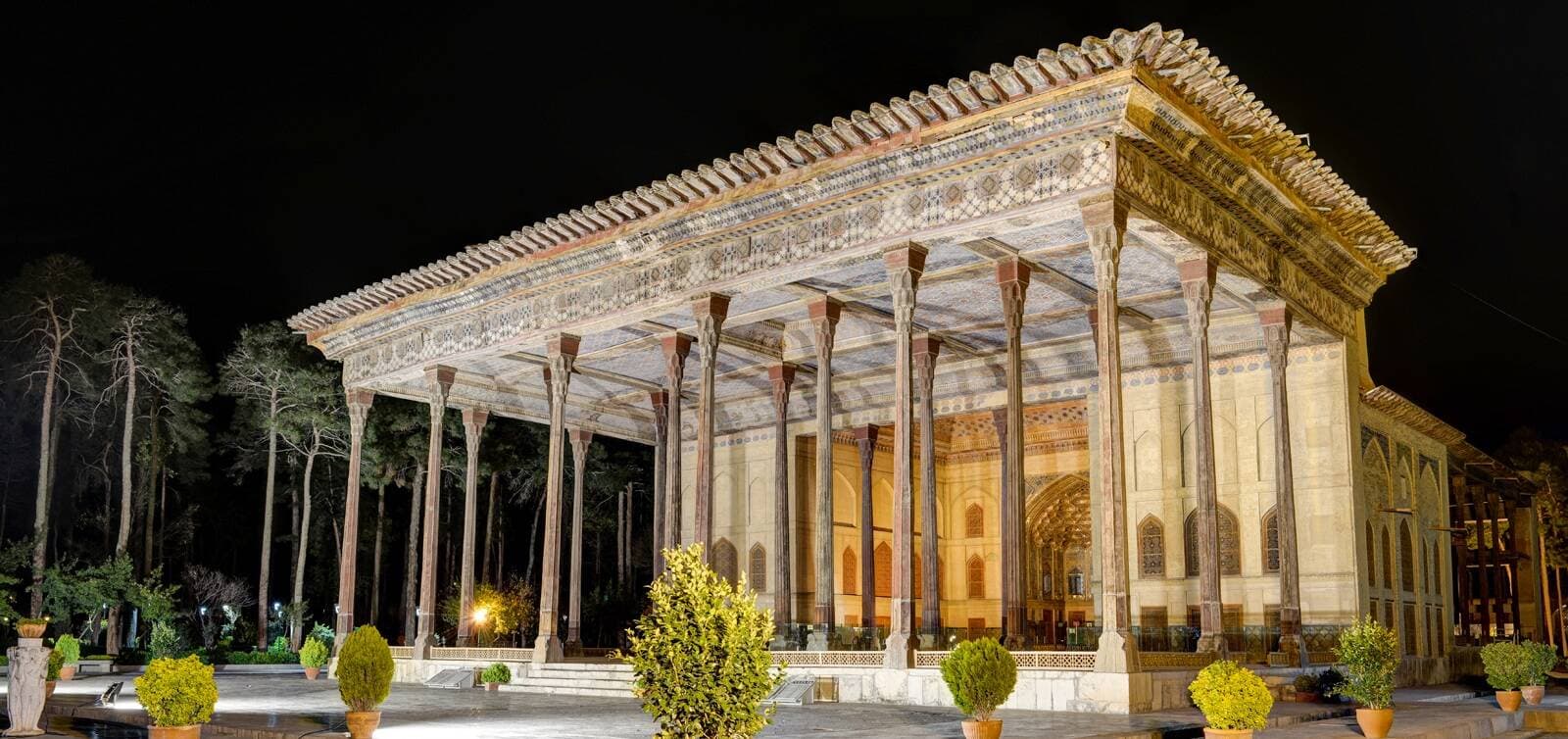
Ali Qapu Palace
Ali Qapu Palace, located on the western side of Naqsh-e Jahan Square in Isfahan, is a magnificent example of Safavid-era architecture and a testament to the grandeur of Shah Abbas I's reign. Constructed in the early 17th century, the palace served as the official residence of the Safavid kings and a venue for entertaining dignitaries and foreign ambassadors. The name "Ali Qapu" translates to "Imperial Gate," highlighting its significance as the gateway to the royal complex.
Standing six stories high, the palace's design is a blend of Persian and Islamic architectural styles, featuring elaborate decorations and innovative structural elements. One of the palace's most striking features is its grand entrance, a lofty portico supported by 18 slender wooden columns. This entrance leads to an elevated terrace that offers breathtaking views of Naqsh-e Jahan Square and the surrounding cityscape. The terrace was often used by Shah Abbas and his court to observe ceremonies and polo matches in the square below.
Inside, Ali Qapu Palace is adorned with intricate frescoes, detailed miniatures, and exquisite stucco work that reflect the artistic achievements of the Safavid period. Each floor of the palace served a distinct purpose, with lower floors used for administrative functions and upper floors reserved for private and ceremonial use. The music room, located on the uppermost floor, is particularly noteworthy for its unique acoustic design. The walls of the music room are decorated with niches and cutouts that not only add to the visual beauty but also enhance the sound quality, allowing for exceptional musical performances.
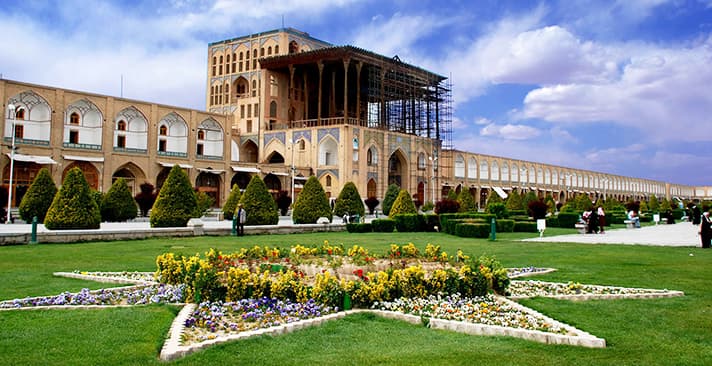
Moshir-al-Molk Historical House
Moshir-al-Molk Historical House, also known as the Museum of Islamic Heritage, is a remarkable architectural gem located in Isfahan's Hatef Street1. This historical house, dating back to the Safavid and Qajar dynasties, was originally the residence of the influential Moshir-al-Molk Ansari family, who served as ministers and secretaries to the Safavid government. The house is a stunning example of traditional Persian architecture, featuring intricate tile work, elegant courtyards, and beautifully decorated rooms.
The main attraction of Moshir-al-Molk Historical House is its spring room, which boasts the largest sash window (orosi) in Iran. This room is designed to provide a cool and refreshing environment during the hot summer months, with water flowing from the sash window to create a natural air conditioning system. The house also features a howz khaneh (pond house), a traditional Persian element used for storing water and providing a serene atmosphere.
Inside the house, visitors can explore a library, gallery, and various halls that showcase the rich cultural heritage of Iran. The library contains a collection of valuable manuscripts, books, and documents, while the gallery displays exquisite examples of Persian calligraphy, painting, and other forms of Islamic art. The halls are adorned with intricate stucco work, colorful tiles, and detailed frescoes that reflect the artistic achievements of the Safavid and Qajar periods. Moshir-al-Molk Historical House has undergone several renovations and restorations over the years, ensuring that its architectural beauty and historical significance are preserved for future generations.
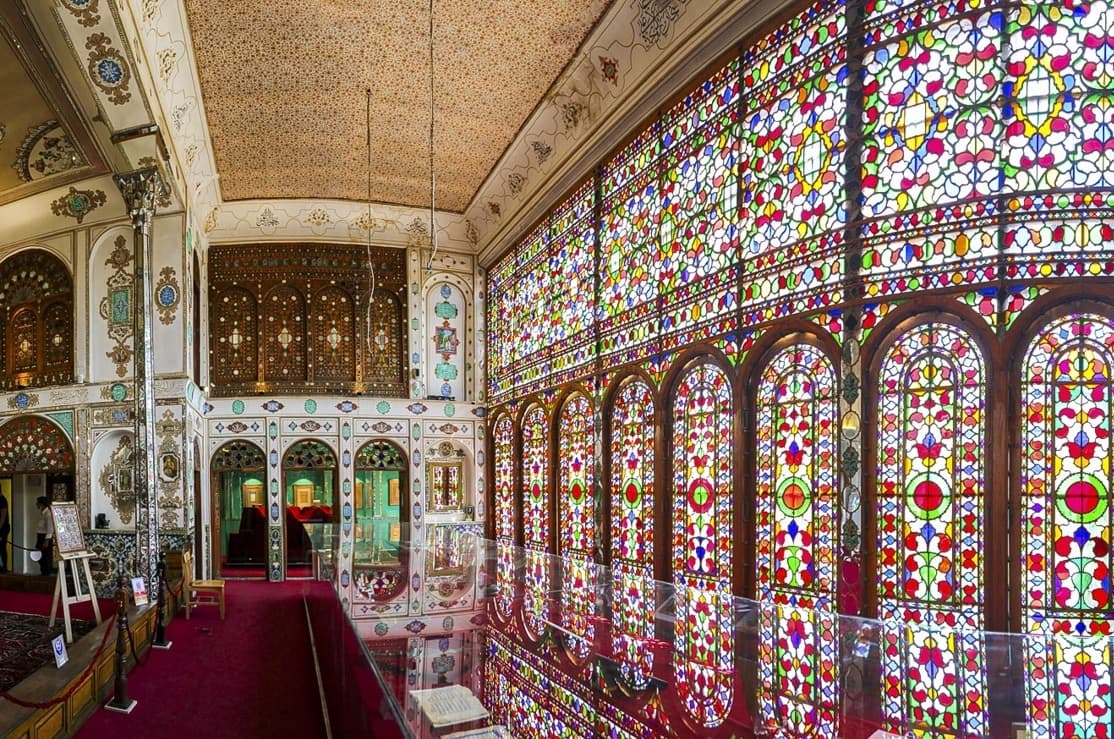
Menar Jonban
Menar Jonban, also known as the Shaking Minarets, is a fascinating and unique historical monument located in Isfahan, Iran. This intriguing structure dates back to the Ilkhanid period, around the 14th century, and is renowned for its unusual architectural feature—its twin minarets that can shake when one of them is pushed. The monument consists of a small, rectangular building housing the tomb of Amu Abdollah Soqla, a mystic hermit, with the minarets rising from either side.
The minarets, each approximately 17 meters tall, are built on a solid brick structure that stands above the tomb. When one minaret is pushed, both minarets shake due to the architectural design and the interconnection of the structure. This phenomenon has intrigued visitors for centuries and continues to draw crowds who come to witness this remarkable sight. The shaking is believed to be a result of the specific construction techniques used, where the minarets' bricks and mortar create a flexible yet resilient structure.
The intricate tile work and brick designs that adorn the Menar Jonban showcase the artistic skills of the era. The patterns and calligraphy on the minarets and the surrounding building reflect the cultural and architectural heritage of the Ilkhanid period. The tomb itself, though modest in size, is a place of quiet reverence, adding to the overall mystique of the site. Menar Jonban is not only an architectural marvel but also a symbol of the ingenuity and creativity of Persian builders. Its ability to shake without collapsing has puzzled and amazed engineers and architects for generations.
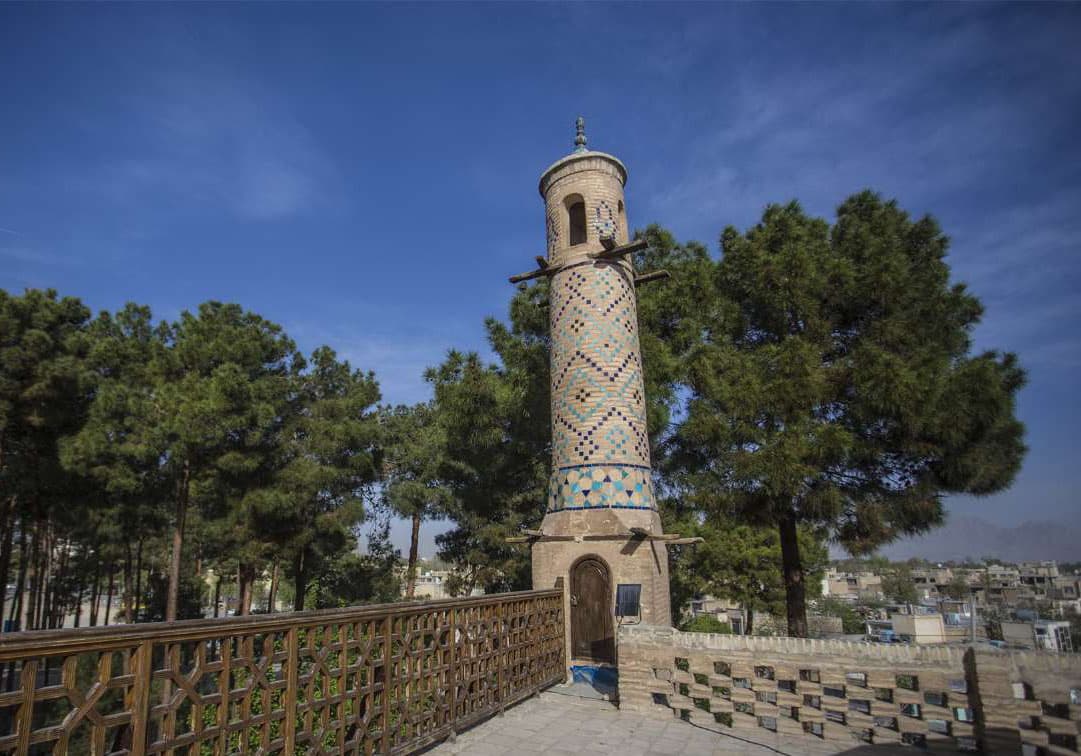
Javaheri Historical House Isfahan
The Javaheri Historical House, located in the heart of Isfahan, Iran, stands as a testament to the city's rich cultural heritage and architectural splendor. Built during the Qajar era, this magnificent structure showcases the intricate craftsmanship and artistic prowess of the time. The house is characterized by its stunning facade, adorned with elaborate tile work, intricate wood carvings, and beautifully designed windows that allow natural light to filter in, creating a serene and inviting atmosphere.
Inside, the Javaheri Historical House reveals a world of opulence and elegance. The interior is adorned with luxurious carpets, ornate chandeliers, and finely crafted furniture, all reflecting the grandeur of the Qajar period. The house features several spacious rooms, each with its unique charm and purpose, including a grand reception hall, cozy living quarters, and a serene courtyard. The courtyard, in particular, serves as a tranquil oasis, with lush greenery, a central fountain, and shaded seating areas, providing a perfect escape from the bustling city outside.
The Javaheri Historical House is not only a marvel of architectural beauty but also a repository of history and culture. It offers visitors a glimpse into the lifestyle and traditions of the Qajar era, showcasing the art, craftsmanship, and social customs of the time. The house has been meticulously preserved, allowing visitors to experience the past in a tangible and immersive way. Today, it serves as a cultural center, hosting exhibitions, workshops, and events that celebrate Isfahan's rich heritage.
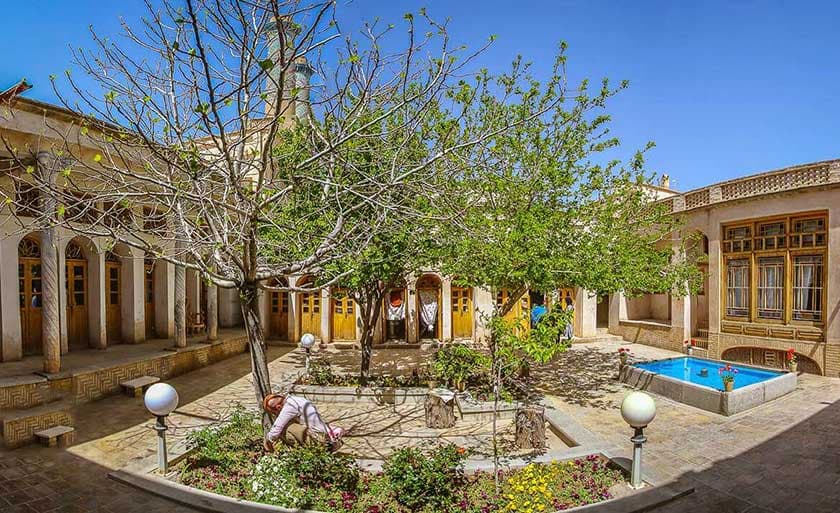
Conclusion
In conclusion, Isfahan's historical places offer a remarkable glimpse into the city's rich cultural and architectural heritage. From the grandeur of Naqsh-e Jahan Square and its surrounding landmarks like the Shah Mosque, Sheikh Lotfollah Mosque, and Ali Qapu Palace to the stunning engineering marvels of the Si-o-se-pol Bridge and Khaju Bridge, Isfahan's historical sites reflect the artistic and architectural brilliance of the Safavid era. The Chehel Sotoun Palace and the Jameh Mosque of Isfahan further showcase the city's deep cultural and religious significance, while sites like Vank Cathedral and Menar Jonban highlight the diverse influences that have shaped Isfahan's identity. Whether admiring the intricate tile work, marveling at the innovative engineering, or simply soaking in the serene beauty of these landmarks, exploring Isfahan's historical places offers a profound appreciation for the city's enduring legacy and its contribution to Iran's rich history.
Read More